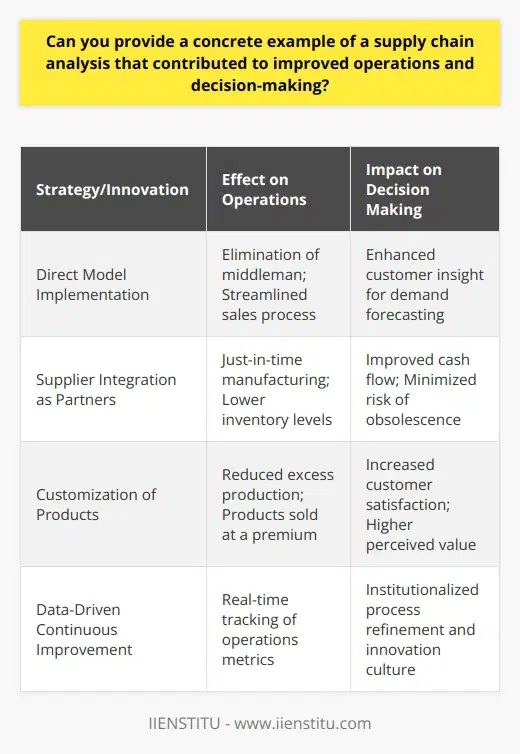
This article explains the importance of understanding customer needs and aligning supply chain plans with those needs to deliver value to customers. It explains a supply chain and how to analyze customer data to understand customer needs. It also discusses customer segmentation, customer journey mapping, and predictive analytics to help supply chain planners understand customer needs and design the supply chain to meet those needs.
Introduction: Analyzing Your Customers
What is a Supply Chain?
Aligning Supply Chain Plans with Customer Needs
Understanding Customer Needs
Analyzing Customers and their Needs
Introduction: Analyzing Your Customers
The supply chain is a complex system of people, processes, and technologies that are designed to deliver value to a customer. While supply chain planners tend to focus on people, processes, and technologies, it is also important to align supply chain plans with customers' needs. Each customer is unique, with specific needs, preferences, and constraints that must be taken into account. To ensure that the supply chain delivers the value customers expect, it is essential to understand their needs and analyze them to ensure that the supply chain meets those needs.
What is a Supply Chain?
A supply chain is a network of organizations, activities, and resources involved in producing and delivering goods and services. It is a complex system that involves multiple stakeholders and requires careful coordination and management. The supply chain includes product design, procurement, production, distribution, and customer service. The goal of the supply chain is to deliver value to customers by providing them with the goods and services they need in a timely and cost-efficient manner.
Aligning Supply Chain Plans with Customer Needs
The success of any supply chain depends on its ability to meet customer needs. To ensure that the supply chain meets customer needs, it is important to align supply chain plans with customer needs. This means understanding each customer’s needs, preferences, and constraints and designing the supply chain to meet those needs. This includes determining the right products, services, and delivery methods to meet customer needs.
Understanding Customer Needs
Understanding customer needs is essential for successful supply chain planning. It is important to analyze customer data and identify trends to understand customer needs. This includes analyzing customer demographics, such as age, gender, and income level. It also analyzes customer behavior, such as purchase patterns, preferences, and satisfaction levels. This data can help supply chain planners understand customer needs and preferences and design the supply chain to meet those needs.
How To Reduce Transportation Costs İn Supply Chain Management
How To Handle Conflicts With Supply Chain Suppliers During An İnterview
Analyzing Customers and their Needs
Analyzing customer data and understanding customer needs is essential for successful supply chain planning. To do this, it is vital to use the right tools and techniques. This includes using customer segmentation to identify different customer groups and their needs, using customer journey mapping to understand how customers interact with the supply chain, and using predictive analytics to identify trends and patterns. These tools can help supply chain planners understand customer needs and design the supply chain to meet those needs.
Conclusion: Analyzing customer needs is essential for successful supply chain planning. It is important to understand each customer’s needs, preferences, and constraints and design the supply chain to meet those needs. It is important to use the right tools and techniques, such as customer segmentation, customer journey mapping, and predictive analytics. By using these tools, supply chain planners can better understand customer needs and design the supply chain to meet those needs.
Knowledge of your customers is the key to unlocking Supply Chain Success.
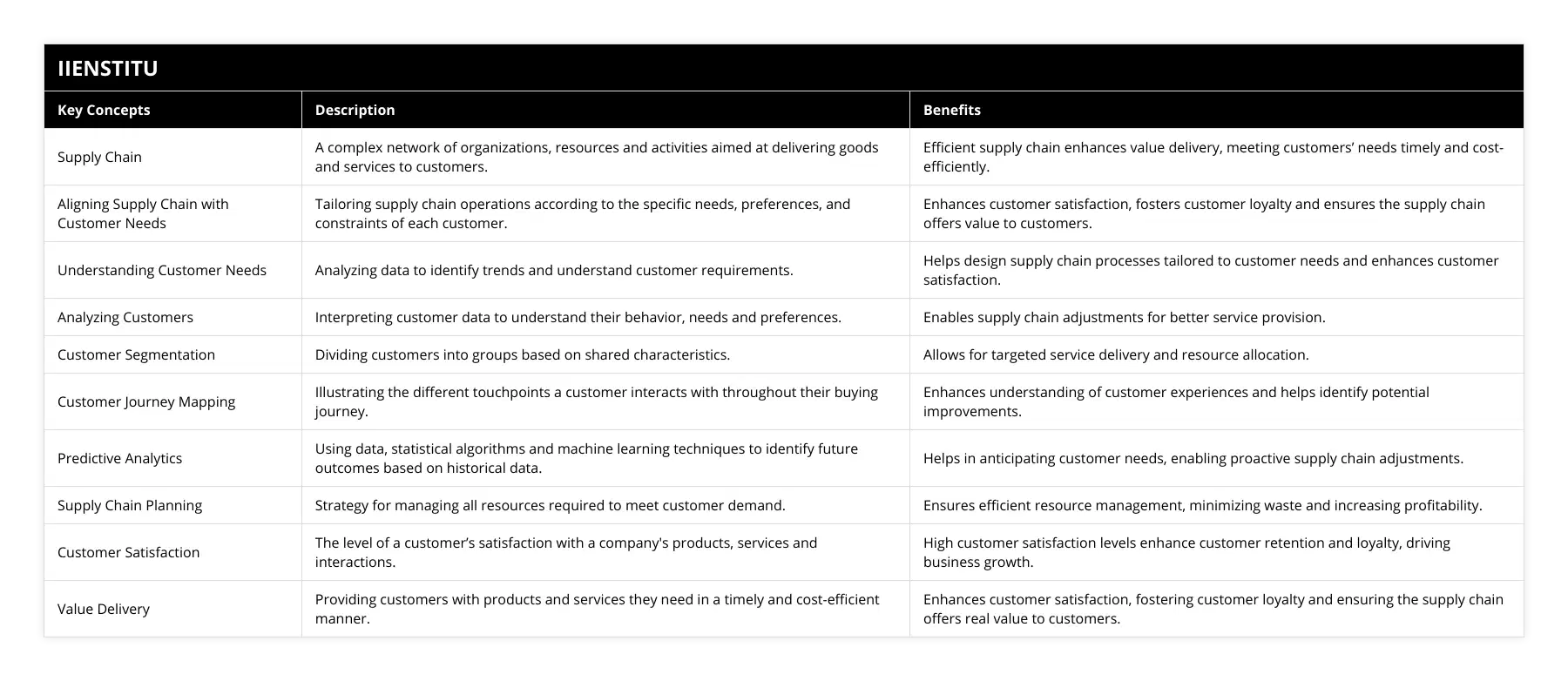
The article emphasized the vital role of comprehending customer wants and aligning supply chain strategies to these demands to generate value for customers. It detailed what a supply chain is and how customer data analysis contributes to understanding their needs. Moreover, it talked about the significance of customer segmentation, customer journey mapping, and predictive analytics for supply chain planners to grasp customer requirements. The successful planning and management of the supply chain system is highly reliant on this understanding and alignment. Hence, getting the appropriate supply chain certification, which includes learning these critical tools and strategies, can provide valuable insights that can lead to supply chain success.
Frequently Asked Questions
Unlocking Supply Chain Success
In recent years, the effective management of the supply chain has become a priority for many businesses. This is due to the increasing complexity of the global marketplace, as well as the need to remain competitive in an ever-evolving business environment. As such, unlocking supply chain success has become a significant focus for many companies.
To achieve this, businesses must first understand the key components of a successful supply chain. These include the identification of customer requirements, the integration and optimization of all supply chain operations, and the adoption of innovative technologies and processes. This enables businesses to develop a comprehensive strategy that meets the needs of their customers while also improving operational efficiency and cost savings.
The next step is to develop a comprehensive plan outlining the activities, processes, and resources required to achieve supply chain success. This plan should include the identification of a clear goal, the development of a comprehensive strategy, the implementation of appropriate processes, and the measurement and evaluation of the results. Additionally, businesses should consider using technology and analytics to optimize the supply chain and ensure that all activities align with the company's overall objectives.
Once the plan is in place, businesses must then focus on implementing the various components of the plan. This includes the development of an effective communication strategy to ensure that all stakeholders are kept informed and engaged in the process. Additionally, businesses must ensure that appropriate resources are allocated to each activity and that processes are continually evaluated and monitored for efficiency and effectiveness. Finally, businesses must ensure that their supply chain is well-managed by leveraging the latest technology, such as data-driven analytics, to track and manage performance.
In conclusion, unlocking supply chain success is a complex and multifaceted process. It requires an understanding of customer requirements, implementing a comprehensive strategy, the application of appropriate processes and technologies, and measuring and evaluating results. By following these steps, businesses can ensure that their supply chain is successful and that they remain competitive in an ever-evolving marketplace.

How can analyzing customers help unlock supply chain success?
Analyzing customers is an important part of understanding and unlocking supply chain success. Through customer analysis, companies can better understand their customers' needs, wants, and preferences. This knowledge can then be used to improve the supply chain in order to increase customer satisfaction and loyalty.
Customer analysis involves collecting and analyzing data related to customers, such as demographics, buying habits, and preferences. Companies can better anticipate and manage supply chain requirements by understanding the customers' needs. For example, understanding what products customers are likely to purchase and when they are likely to purchase them can help companies optimize their inventory levels and improve the efficiency of their supply chains.
In addition to understanding customer preferences, customer analysis can help companies identify potential areas of improvement. By analyzing customer feedback and complaints, companies can identify areas of their supply chain that may be causing delays or other issues. This knowledge can then be used to make appropriate changes to reduce or eliminate these problems.
Finally, customer analysis can help companies identify opportunities for collaboration. By understanding customer preferences, companies can identify potential partners who may be better equipped to meet customer demands. This can lead to improved efficiency and more effective supply chain management.
In conclusion, analyzing customers is critical to understanding and unlocking supply chain success. Through customer analysis, companies can better understand customer needs, wants, and preferences. This knowledge can then be used to improve the supply chain, identify areas of improvement, and identify potential opportunities for collaboration.
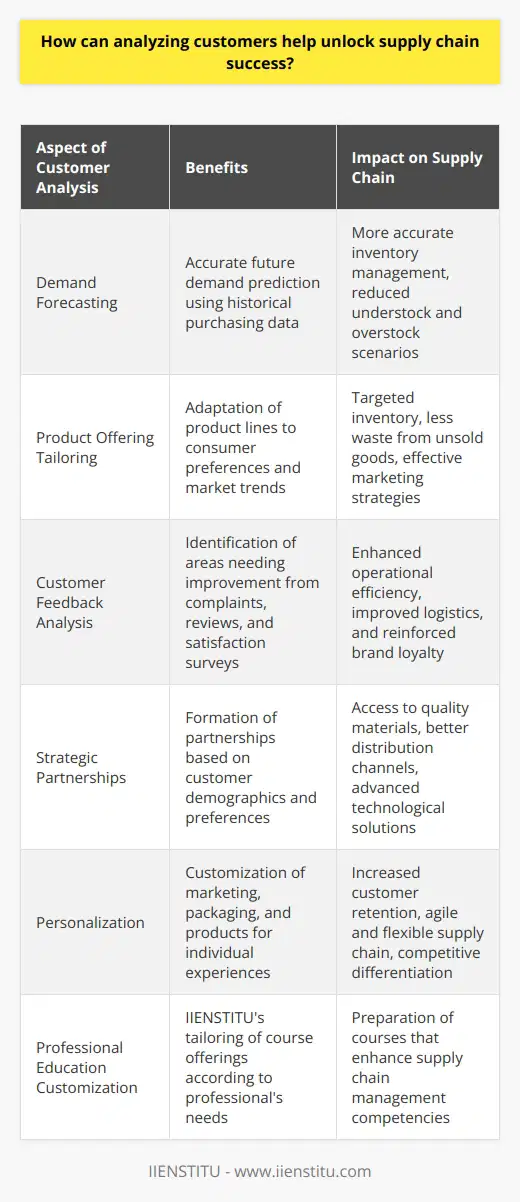
What are the benefits of aligning supply chain plans with customer needs?
In today’s business environment, there is a need to ensure that customer needs are taken into consideration when creating supply chain plans. Aligning supply chain plans with customer needs can help organizations to increase their efficiency and boost their customer satisfaction.
One of the main benefits of aligning supply chain plans with customer needs is improved efficiency. By understanding customers' needs, businesses can better design their supply chains to meet those needs. This can result in shorter lead times, increased speed to market, and improved customer service. Additionally, businesses can better allocate resources and reduce costs by optimizing their supply chains according to customer needs.
Another benefit of aligning supply chain plans with customer needs is improved customer satisfaction. By understanding customer needs, businesses can ensure that their supply chains provide the right products at the right time. This can help increase customer satisfaction, as customers can access the products they need when they need them. Additionally, businesses can use customer feedback to improve their supply chains and meet customer needs.
Finally, aligning supply chain plans with customer needs can also help businesses to gain a competitive advantage. By understanding customer needs, businesses can create innovative supply chain solutions to help them stand out from their competitors. Additionally, businesses can use customer feedback to identify opportunities for improvement and create new products or services that will meet customer needs.
In conclusion, aligning supply chain plans with customer needs has many benefits. By understanding customer needs, businesses can improve their efficiency, boost customer satisfaction, and gain a competitive advantage. Therefore, it is important for businesses to consider customer needs when creating supply chain plans.
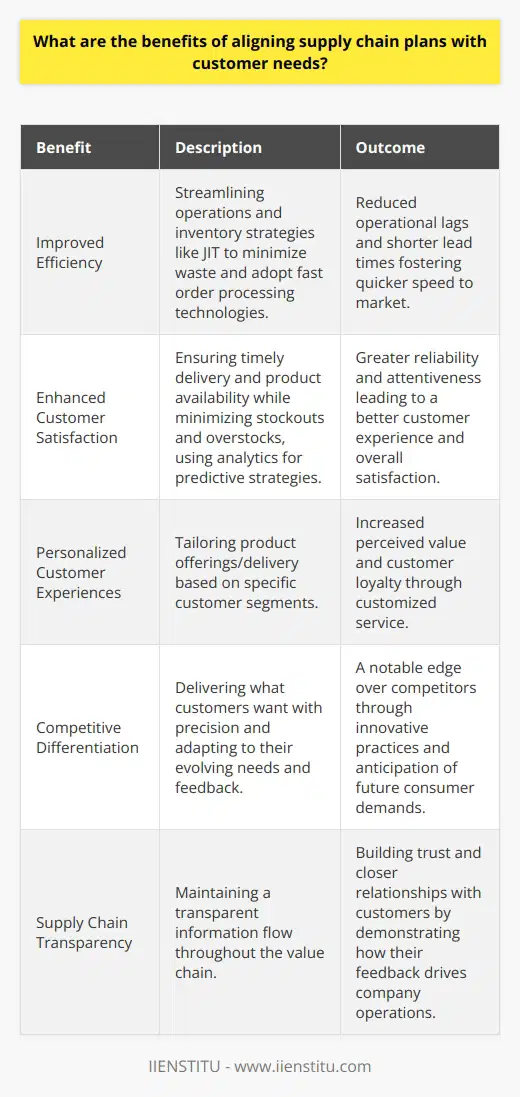
How do you analyze supply chain processes to optimize efficiency and reduce costs?
Understanding the Current State
To optimize efficiency and reduce costs in supply chain processes, it is essential to first understand the current state of the supply chain. This involves mapping out processes, assessing the performance of existing systems, and identifying bottlenecks and inefficiencies. This can be achieved through data collection and analysis, which helps determine patterns, trends, and areas for improvement.
Evaluating Key Performance Indicators (KPIs)
In order to analyze supply chain processes effectively, it is necessary to establish relevant KPIs. Common KPIs include on-time delivery, stock levels, lead times, and inventory turnover rates. By tracking these, the organization can measure progress and identify areas of concern related to efficiency and cost performance. Comparing these metrics to industry benchmarks can be an effective method for identifying potential process improvements.
Examining Supplier Relationships
Effective supplier relationships are crucial to supply chain efficiency. Therefore, an analysis of the relationships between suppliers, manufacturers, and customers provides useful insight into possible cost-saving opportunities. This may include evaluating supplier performance, assessing contractual arrangements, and conducting periodic performance reviews to foster communication and long-lasting partnerships.
Implementing Lean Principles
Lean principles have been widely adopted by many organizations to improve supply chain efficiency and reduce costs. By eliminating waste, minimizing lead times, and enhancing overall process flow, lean principles provide a solid framework for supply chain optimization. An organization may consider reviewing its supply chain processes against lean principles, and if necessary, undergo a lean transformation that can result in significant cost savings and improved performance.
Utilizing Advanced Technologies
In today's technology-driven market, utilizing advanced technologies to optimize supply chain processes is of paramount importance. This may include implementing automated systems for inventory management, forecasting, or demand planning. Additionally, investing in data analytics tools can provide valuable insights to guide decision-making processes that aid in enhancing supply chain efficiency and reducing costs.
Continuous Improvement
Ultimately, supply chain optimization is an ongoing process that requires continuous improvement and adaptation. Regularly monitoring and measuring supply chain performance, applying best practices, and adopting new technologies as they become available enables organizations to maintain efficiency and reduce costs in the long run. A commitment to continuous improvement within the supply chain is vital to remaining competitive and achieving operational excellence.
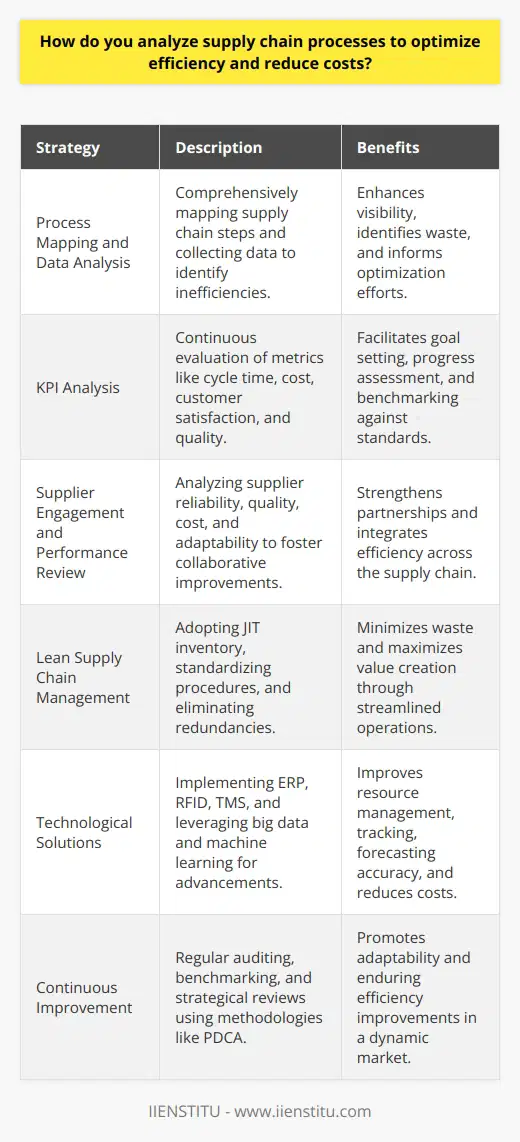
What is the most important factor to consider when evaluating the effectiveness of a supply chain analytics project?
Key Factor: Alignment with Strategic Goals
When evaluating the effectiveness of a supply chain analytics project, the most important factor to consider is its alignment with the organization's strategic goals. To assess this alignment, managers should determine how well the project supports the organization's key performance indicators (KPIs) and long-term objectives.
Data Quality and Accuracy
An effective supply chain analytics project requires accurate and reliable data. Managers should assess the quality of the data used in the project, including measuring data completeness, consistency, and validity. Data accuracy directly impacts the project's utility, as flawed data can lead to incorrect insights and poor decision-making.
Integration with Operational Processes
Supply chain analytics projects should also be evaluated based on their ability to integrate with existing operational processes. Integration is key to ensuring that the insights produced by the analytics project are actionable and can be implemented easily within the organization. Evaluating this factor requires examining how well the project interfaces with core system technologies, as well as assessing the level of user adoption among key stakeholders.
Adaptability to Changing Business Needs
Supply chain environments are constantly evolving, and analytics projects must be adaptable to remain effective. Managers should consider whether the project can easily accommodate changes in the business environment, such as fluctuations in demand, shifting regulations, or the emergence of new competitors. An adaptable project will demonstrate flexibility, scalability, and a capability to evolve alongside the organization's needs.
Return on Investment (ROI)
Lastly, the effectiveness of a supply chain analytics project should be measured by its return on investment. Evaluating ROI involves calculating the financial gains generated by the project, such as cost savings or increased revenues, and comparing them to the project's overall expenses. A high ROI indicates that the analytics project has delivered value to the organization and justifies further investment in similar initiatives.
In conclusion, the effectiveness of a supply chain analytics project hinges on its alignment with strategic goals, data quality, integration with operational processes, adaptability to changing business needs, and return on investment. By considering these factors, managers can make informed decisions about the success of their analytics projects and strategize effectively for future supply chain improvements.
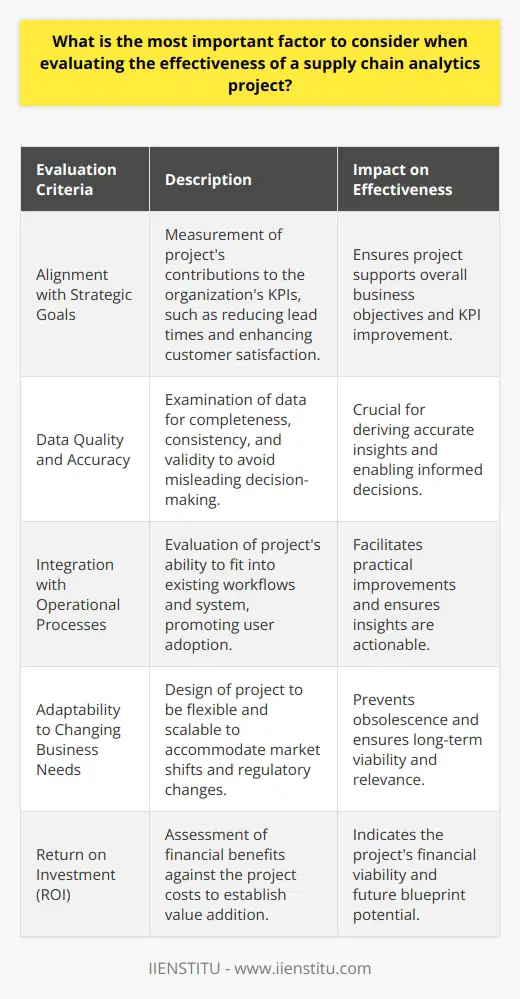
Can you provide a concrete example of a supply chain analysis that contributed to improved operations and decision-making?
Case Study: Dell Inc's Supply Chain Analysis
Overview of Dell's Supply Chain Strategy
A prime example of successful supply chain analysis leading to improved operations and decision-making is the case of Dell Inc, a global technology company. Dell, known for manufacturing personal computers, servers, and other electronic devices, revolutionized its supply chain through its 'Direct Model' strategy, tying production to customer orders.
Demand Forecasting and Inventory Management
Dell's supply chain analysis involved accurate demand forecasting and inventory management to maximize efficiency. By tracking trends in customer orders, Dell identified patterns in demand, enabling the prediction of future demand with a higher degree of certainty. These forecasting strategies, coupled with reduced inventory levels, helped Dell minimize inventory costs, decrease lead times, and decrease waste from overproduction.
Supplier Integration and Collaboration
Another key element of Dell's supply chain analysis was the integration and collaboration with suppliers. Dell adopted a 'just-in-time' (JIT) production system, requiring suppliers to maintain inventories and deliver components as needed. This approach allowed Dell to foster strong relationships with suppliers, improve product quality, and enable better control over the supply chain.
Customization and Cost Reduction
Dell's 'Direct Model' enabled customization, wherein customers could configure their computer systems according to personal specifications. This approach contributed to Dell's ability to reduce overall costs by eliminating intermediaries, ensuring more efficient production processes, and maintaining close communication with customers, which translated to better understanding and catering to their needs.
Continuous Improvement and Adaptation
Dell's supply chain analysis not only targeted immediate improvements but also focused on continuous learning and adaptation. By utilizing sophisticated analytical tools, Dell continuously assessed performance metrics, identified areas for improvement, and incorporated constant changes to maintain their competitive advantage.
Conclusion: Dell's Success in Supply Chain Analysis
In conclusion, the case of Dell Inc demonstrates the power of supply chain analysis in transforming corporate operations and improving decision-making. Its strategic 'Direct Model,' effective demand forecasting and inventory management processes, supplier integration and collaboration, customization, and commitment to continuous improvement served as prime drivers of its success. This example highlights the potential benefits of conducting supply chain analyses as a means to enhance operational efficiency, meet customer demands, and gain a competitive advantage.
